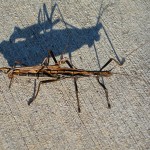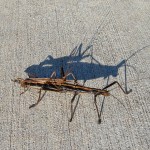They have them there for you already!
This afternoon’s family excursion to our favorite natural area in Boca Raton allowed us all, after getting squeaky clean, to check up on the Least Grebes (still there), check for the Snow Goose that was reported there on Friday (apparently skipped town already), and enjoy a raptorial trifecta: Osprey, American Kestrel, and Merlin. Only one of the images below (the Merlin) is from today; it was very windy, and the best chances I got at capturing them in my digiscoping setup just didn’t work out: too much camera shake, too many jerks walking through and flushing the birds, giving me a beautifully in focus, but empty, perch:
On our way out, after all the disappointments (photographically speaking) with the birds, we literally ran across (but not over) a new insect for me: Anisomorpha buprestoides, the Two-striped Walkingstick, in what looked like a rather intimate moment. However, opinions seem mixed on this score. According to this page, which seems rather authoritative, the large female is frequently found with the smaller male hitching a ride (the caption actually describes the insect “as usually seen” with male and female together). It’s not necessarily a private moment; just a lucky one for the observer.
On the other hand, according to my Marshall, the entire family Phasmatidae are “famous for their long copulations,” sometimes lasting for days. Of course, A. buprestoides is in the family Pseudophasmatidae, not Phasmatidae, although both families are in the order Phasmida. (For more on the complex taxonomy of the walkingsticks, try the Phasmida Species File page; there’s enough there to keep you busy for hours.) My Kaufman repeats the story of the long pairing periods of the genus Anisomorpha; my NWF sticks to the anodyne description: “Males are often seen on the backs of females.”
This being November, though, it’s quite possible that these guys were in fact attempting to ensure the survival of the species; apparently this is the season for oviposition.
I do have to say that this was quite a lucky observation on my part, in more ways than one. Not only was it my first sighting of this species, and I got to see both male and female, in action, as it were. I also escaped without experiencing the noxious spray that they produce when threatened. The spray is apparently not just foul-smelling, but the terpenes in it can cause temporary blindness if it gets in the observer’s (or innocent bystander’s) eyes! (For more on this, refer to the IFAS page and scroll down to the bottom, “Defensive Secretion” and “Medical Importance.”)
Fortunately for all and sundry in our party, the only stinkbomb we encountered was after we got home, and discovered someone in need of a change, and no one was blinded, although quite a few were reported to be gagging…







1 thought on “When at the scrub, no need to bring your walking stick…”